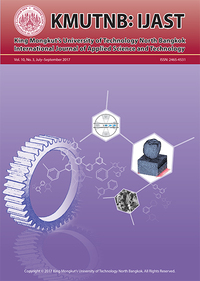Development of Normal and Reduced Fat Formulas of Coconut and Gac (Momordica cochinchinensis Spreng) Aril Flavored Ice Cream
Main Article Content
Abstract
This research aimed to develop normal and reduced fat formulas of coconut and gac aril flavored ice cream. It was determined that the suitable formula for developing the normal of coconut and gac aril flavored ice cream based on the most acceptable to consumers and has the lowest melting rate was 34.85% gac aril juice, 45.15% coconut milk, and 20% sugar. For the development of the reduced fat formula that could reduce the highest amount of fat while giving the highest acceptance scores, the variables studied were the type of fat replacer (soy protein, maltodextrin, and soy protein mixed with maltodextrin in a ratio of 1:1) and amount of fat replacer (30, 50, and 70% of fat in ice cream). It was found that the use of soy protein mixed with maltodextrin as a fat replacer at 50% was suitable for the production of the reduced fat formula of coconut and gac aril flavored ice cream (average overall acceptance was 6.53±1.43 points). The results showed that consumers cannot distinguish the differences of the normal and reduced fat formulas of coconut and gac aril flavored ice cream. For the melting rate, the reduced fat formula ice cream had a significantly lower melting rate than the normal formula ice cream.
Article Details
References
[2] B. K. Ishida, C. Turner, M. H. Chapman, and T. A. McKeon, “Fatty acid and carotenoid composition of gac (Momordica cochinchinensis Spreng) fruit,” Journal of Agricultural and Food Chemistry, vol. 52, no. 2, pp. 274–279, 2004.
[3] L. T. Vuong, S. R. Dueker, and S. P. Murphy, “Plasma β-carotene and retinol concentrations of children increase after a 30-d supplementation with the fruit Momordica cochinchinensis (gac),” American Journal of Clinical Nutrition, vol. 75, no. 5, pp. 872–879, 2002.
[4] H. Aoki, N. T. M. Kieu, N. Kuze, K. Tomisaka, and N. V. Chuyen, “Carotenoid pigments in gac fruit (Momordica cochinchinensis Spreng),” Bioscience, Biotechnology, and Biochemistry, vol. 66, no. 11, pp. 2479–2482, 2002.
[5] L. T. Vuong, A. A. Franke, L. J. Custer, and S. P. Murphy, “Momordica cochinchinensis Spreng (gac) fruit carotenoids reevaluated,” Journal of Food Composition and Analysis, vol. 19, no. 6–7, pp. 664–668, 2006.
[6] L. E. Cancel, “Coconut food product and bases,” in J. G. Woodroof (Ed.). Coconuts: Production Processing Product, 2nd ed. New York: The AVI Publishing Company, Inc., Westport, 1979, pp. 202–239.
[7] C. C. Seow and C. N. Gwee, “Coconut milk: Chemistry and technology,” International Journal of Food Science and Technology, vol. 32, pp. 189–201, 1997.
[8] Anonymous, “Fat substitute update,” Food Technology, vol. 44, no. 3, pp. 92–97, 1990.
[9] K. B. Chin, J. T. Keeton, M. T. Longnecker, and J. W. Lamkey, “Utilization of soy protein isolate and konjac blend in a low fat bologna (model system),” Meat Science, vol. 53, pp. 45–57, 1999.
[10] R. T. Marshall and W. S. Arbuckle, Ice cream, 5th ed., New York: International Thomson Publishing, 1996, pp. 349
[11] C. H. White, “Low-fat dairy products,” in A. M. Altschul (Ed). Low-Calorie Food Handbook, New York: Marcel Dekker, Inc, 1993, pp. 253–271.
[12] W. S. Arbuckle, Ice cream. 4th ed., New York: The AVI Publishing Company, Inc., Westport, 1986, pp. 843
[13] H. D. Goff and R. W. Hartel, “Ice cream and frozen desserts,” in Y. H. Hui (Ed). Handbook of Frozen Foods, Marcel Dekker, Inc., 2004, pp. 499–570.
[14] O. B. Karaca, M. Guven, K. Yasar, and S. Kaya, “The functional, rheological and sensory characteristics of ice creams with various fat replacers,” International Journal of Dairy Technology, vol. 62, pp. 93–99, 2009.
[15] W. G. Geilman and D. E. Schmidt, “Physical characteristics of frozen desserts made form ultrafiltered milk and various carbohydrates,” Journal of Dairy Science, vol. 75, no. 10, pp. 2670–2675, 1992.
[16] AOAC, Official Method of Analysis of AOAC International. 17th ed. Association of Official Analytical Chemists, Virginia, 2000.
[17] J. L. Chang, R. T. Marshall, and H. Heymann, “Cascin micelles partially hydrolyzed by chymosin to modify the texture of low fat ice cream,” Journal of Dairy Science, vol. 78, no. 12, pp. 2617–2623, 1995.
[18] M. Nagata and I. Yamashita, “Simple method for simultaneous determination of chlorophyll and carotenoids in tomato fruit,” Journal of The Japanese Society for Food Science and Technology-nippon Shokuhin Kagaku Kogaku Kaishi, vol. 39, pp. 925–926, 1992.
[19] K. Kailasapathy and W. Songvanich, “Effect of replacing fat in ice cream with fat mimetics,” Food Australia, vol. 50, no. 4, pp. 169–173, 1998.
[20] A. M. Roland, L. G. Phillips, and K. J. Boor, “Effects of fat content on the sensory properties, melting, color, and hardness of ice cream,” Journal of Dairy Science, vol. 82, pp. 32–38, 1999.
[21] P. Walstra and M. Jonkman, “The role of milkfat and protein in ice cream,” in Ice Cream. Brussels: International Dairy Federation, 1998, pp. 17–24.
[22] R. L. Ohmes, R. T. Marshall, and H. Heyman, “Sensory and physical properties of ice cream containing milk fat or fat replacers,” Journal of Dairy Science, vol. 81, no. 5, pp. 1222–1228, 1998.
[23] J. V. Leland, “Flavor interactions: The greater whole,” Food Technology, vol. 51, no. 1, pp. 75–80, 1997.
[24] K. B. Roos, “How lipids influence food flavor,” Food Technology, vol. 51, no. 1, pp. 60–62, 1997.

